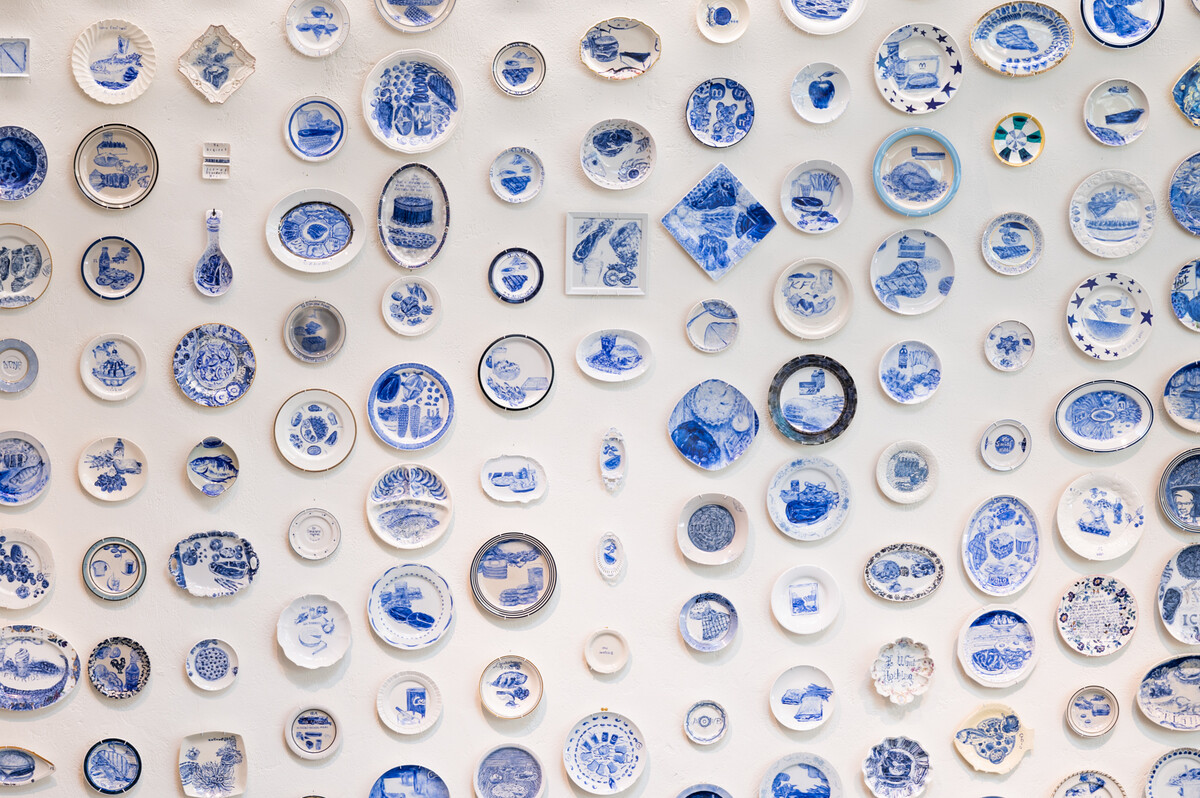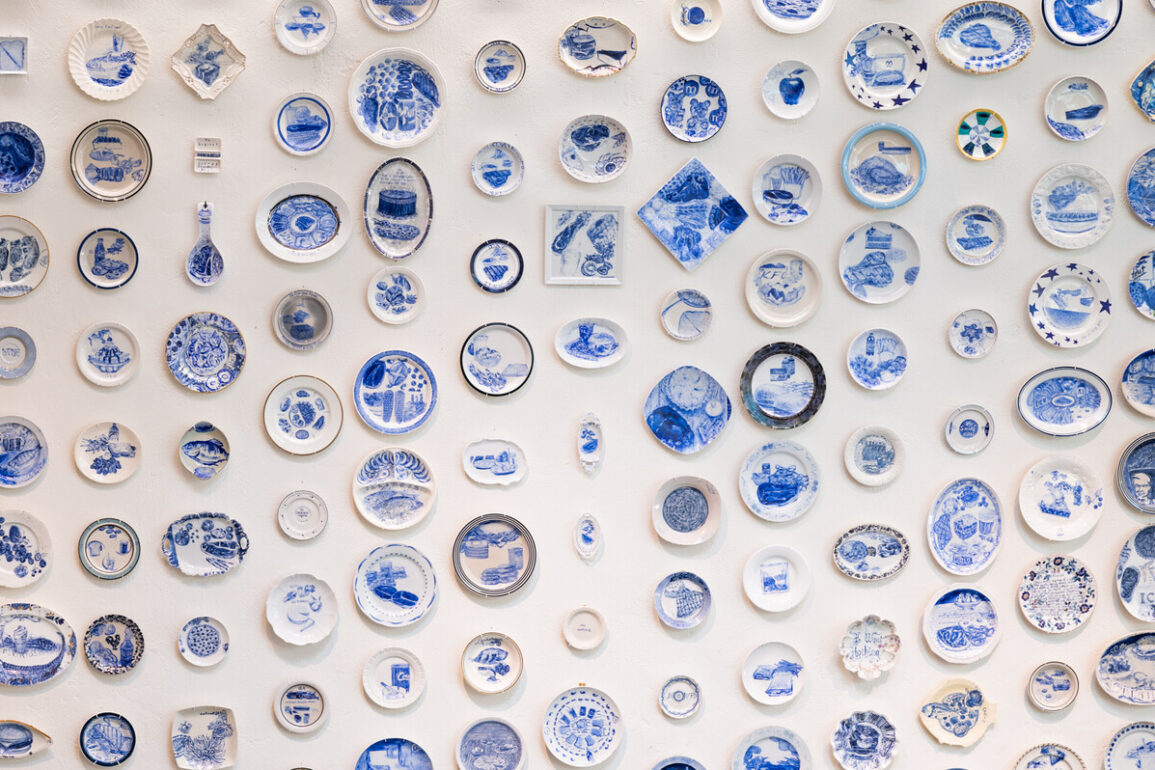
In 2000, American artist Julie Green (1961-2021) conceived a monumental, open-ended project entitled The Last Supper. Green, who was a professor at Oregon State University in Corvallis, set out to paint the last meal requests of death row inmates on second-hand ceramic plates, using cobalt blue mineral paint. Although often unfulfilled by prison officials, last meal requests are nevertheless recorded and are part of the public record of executions in 36 states. Green (who used they as a pronoun) intended to paint 50 plates a year, spending their winter months on The Last Supper, and ending the series upon the abolition of capital punishment in the United States. At the time of the artist’s death in 2021, the project encompassed one thousand plates.
Over two decades, The Last Supper has exhibited throughout the United States and has been widely covered in media. Many exhibitions took place in states which account for a large proportion of executions, such as Texas. The plates of The Last Supper are displayed as a complete set, organized by the state in which an execution took place, thus providing a visual quantification by region. Viewers also may draw inferences about a prisoner from the date and the nature of food requested, information that Green incorporated into the paintings (prisoner names are never shown).
The Last Supper often met with divided reactions. Green was criticized by some as sympathetic to or even capitalizing on those who had been convicted of atrocious crimes. Although the artist did not conceal their opposition to capital punishment, they did not make personal opinion the center of their work. Green preferred to let visual description create a space in which viewers, regardless of opinion, reflect on questions of agency in a nation with a complex carceral system. In a 2013 feature in the New York Times, Kirk Johnson wrote that the “underlying and compelling theme of the work is choice. What do people who may have lived for years in prison with virtually no choices at all do with this last one they’re offered?”
Before their death from ovarian cancer in late 2021, Green placed the work in a trust to develop a solution to conserve and exhibit the artwork in perpetuity. The Last Supper Irrevocable Trust approached Crystal Bridges Museum of American Art and its partner organization Art Bridges in 2022 to discuss a gift of the artwork, which was finalized in June of this year.
Trustee Grace Kook-Anderson, Arlene and Harold Schnitzer Curator of Northwest Art at the Portland Art Museum in Portland, Oregon, remarked that “The Last Supper is an important, uniquely American artwork. I can’t imagine a better home for it than Crystal Bridges, a collection that is actively engaged in the interpretation of what it means to be American.” Kook-Anderson continued, “We are especially excited about the potential for Julie’s work to be seen not only in Bentonville but across the US through Crystal Bridges’ partnership with Art Bridges, which provides funding to museums of all sizes nationwide to exhibit work that engages local audiences.”
“Julie Green’s The Last Supper is a powerful addition to our collection here at Crystal Bridges,” said Alejo Benedetti, the museum’s curator of contemporary art. “This work is a fiercely moving reflection on an aspect of the American story that is often pushed to the margins. It’s Julie foregrounding humanity in a meaningful way around a tremendously complex topic. We look forward to sharing this work with our visitors, knowing that great artists can help guide us into some of our country’s most difficult discussions with stirring elegance and grace.”
The Last Supper, which was most recently exhibited in Bellevue, Washington, has been in storage for a year. The artwork will join the Crystal Bridges Museum of American Art collection in late 2024 for a period of conservation and documentation prior to planning future exhibitions.
More information
Crystal Bridges Museum of American Art
Michelle Moore, Public Relations Manager: michelle.moore [at] crystalbridges.org / T 504.250.4805 (cell)
The Last Supper Irrevocable Trust
Grace Kook-Anderson, Trustee: grace.kook-anderson [at] pam.org / T (503) 276-4293
About Julie Green
Julie Green (1961–2021) was born in Yokosuka, Japan, and received a BFA and MFA from The University of Kansas. Green taught as professor of art at Oregon State University. Awarded a 2017 Hallie Ford Fellowship in the Visual Arts from The Ford Family Foundation, Green also received a 2011 Joan Mitchell Foundation Painters and Sculptors Grant, the 2015 ArtPrize 3-D Juried Award, a 2016 Fellowship and a 2017 Career Opportunity Grant from the Oregon Arts Commission. In the artist’s lifetime, Green had forty-four solo exhibitions in the US and internationally including The Block Museum, Hunter Museum of American Art, and University of Liverpool Art Museum. Collections include The Library of Congress, State of Oregon Library, Spencer Museum of Art, Fidelity Investments, Athena Art Finance, and private collections worldwide.
About Crystal Bridges Museum of American Art
The mission of Crystal Bridges Museum of American Art is to welcome all to celebrate the American spirit in a setting that unites the power of art with the beauty of nature. Since opening in 2011, the museum has welcomed more than 10.8 million visitors across its spaces, with no cost for admission. Crystal Bridges was founded in 2005 as a non-profit charitable organization by arts patron and philanthropist, Alice Walton. The collection spans five centuries of American masterworks from early American to current day and is enhanced by temporary exhibitions. The museum is nestled on 120 acres of Ozark landscape and was designed by world-renowned architect Moshe Safdie. A rare Frank Lloyd Wright-designed house was preserved and relocated to the museum grounds in 2015. Crystal Bridges offers public programs including lectures, performances, classes, and teacher development opportunities. Some 300,000 school children have participated in the Willard and Pat Walker School Visit program, which provides educational experiences for school groups at no cost to the schools. Additional museum amenities include a restaurant, gift store, library, and five miles of art and walking trails. In February 2020, the museum opened the Momentary in Downtown Bentonville (507 SE E Street), conceived as a platform for the art, food, and music of our time. For more information, visit CrystalBridges.org. The museum is located at 600 Museum Way, Bentonville, Arkansas 72712.
About Art Bridges Foundation
Art Bridges Foundation is the vision of philanthropist and arts patron Alice Walton. The mission of Art Bridges is to expand access to American art in all regions across the United States. Since 2017, Art Bridges has been creating and supporting programs that bring outstanding works of American art out of storage and into communities. Art Bridges partners with a growing network of over 220 museums of all sizes and locations on nearly 700 projects across the nation, impacting over 4.1 million people, to provide financial and strategic support for exhibition development, loans from the Art Bridges Collection, and programs designed to educate, inspire, and deepen engagement with local audiences. The Art Bridges Collection represents an expanding vision of American art from the 19th century to present day and encompasses multiple media and voices. For more information, visit artbridgesfoundation.org.
This post was originally published on this site be sure to check out more of their content.







